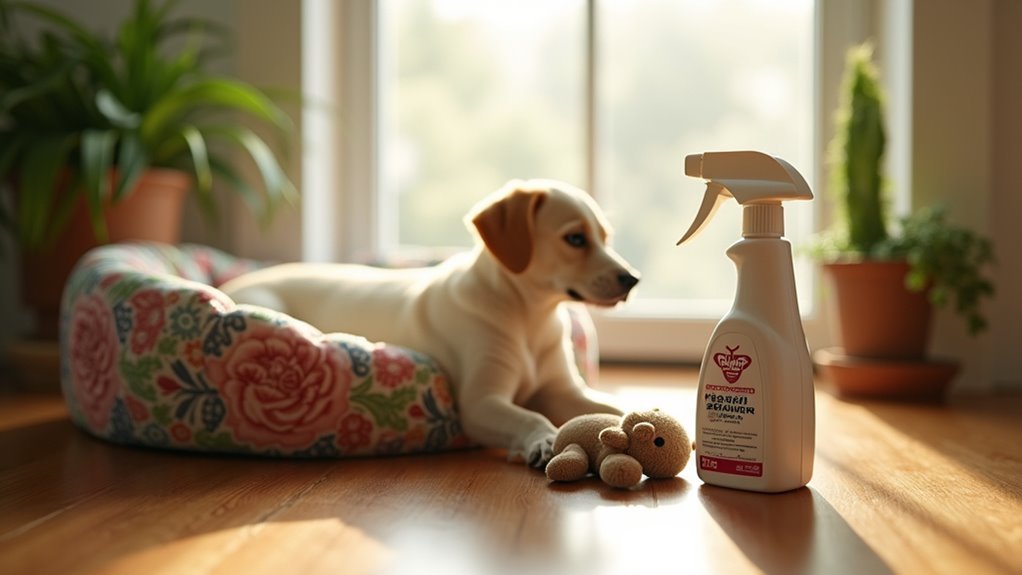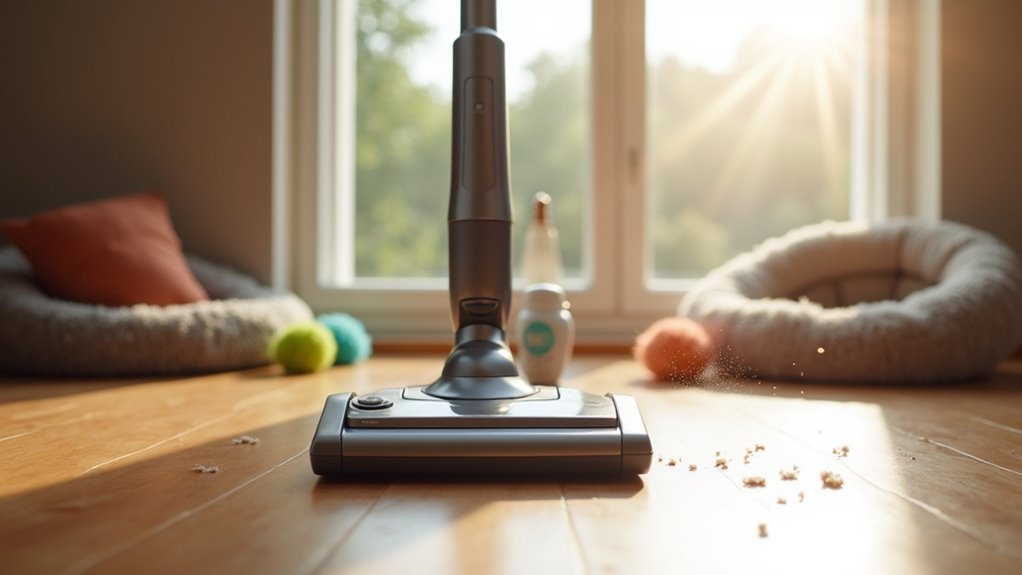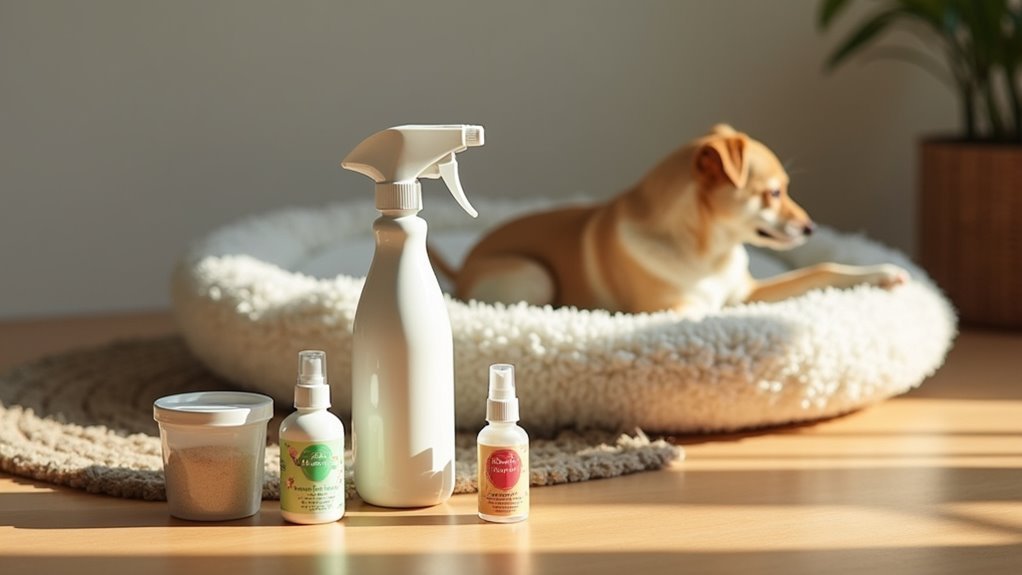You can safely eliminate bed bugs from your pet-filled home using heat treatment at temperatures above 120°F, food-grade diatomaceous earth applied strategically away from pet areas, and thorough vacuuming with sealed disposal bags. Steam cleaning kills bugs on contact without chemicals, while pet-safe essential oil sprays like Bed Bug Patrol show 83% effectiveness. Combine these with mattress encasements and bed bug interceptors for chemical-free monitoring. These proven methods protect your furry friends while extensive strategies guarantee complete elimination.
Understanding Bed Bugs and Pet Safety Concerns

When bed bugs invade your home, they don’t discriminate between you and your furry companions. These parasitic insects feed on warm-blooded animals, targeting both people and pets during nighttime hours.
Bed bugs are equal opportunity pests that feed on both humans and pets without distinction during nighttime feeding sessions.
While they don’t transmit diseases, their bites cause itchy welts that can lead to secondary infections if scratched.
You’ll need to exercise caution when addressing bed bug infestations, as many traditional treatments pose risks to your pets. Essential oils in natural sprays can be toxic to cats and dogs if inhaled or ingested.
That’s why pet-safe solutions are vital for households with animals.
Look for signs like shed exoskeletons, droppings, and blood stains in areas your pets frequent.
When selecting treatments, choose products specifically designed to protect both people and pets while effectively eliminating these persistent pests.
Heat Treatment Methods That Keep Pets Safe
Heat treatment offers one of the safest and most effective approaches for eliminating bed bugs while protecting your pets from chemical exposure.
These pet-friendly heat treatment methods expose bed bugs and their eggs to temperatures above 120°F for extended periods, ensuring complete elimination.
High-temperature machines like steam cleaners work exceptionally well on mattresses and soft fabrics, killing bed bugs on contact without harmful chemicals.
You’ll need to vacuum thoroughly before applying heat treatment to reduce the population and enhance effectiveness.
Remove your pets during the treatment process to prevent overheating or stress. They can safely return once areas cool down.
Monitor treated spaces regularly afterward, as missed eggs might hatch later, requiring follow-up treatments to maintain your pets’ safety.
Pet-Safe Diatomaceous Earth Application Techniques

You’ll need to master specific application methods when using food-grade diatomaceous earth to eliminate bed bugs without endangering your pets.
Focus on creating strategic placement zones where your animals don’t frequent, such as behind furniture or along baseboards they can’t access.
Implement clear avoidance strategies by applying DE only when pets are safely confined to other areas of your home.
Proper DE Application Methods
Three essential steps guarantee diatomaceous earth application remains safe for your furry companions while effectively targeting bed bugs.
First, select food-grade DE that’s non-toxic to pets, affirming your application methods prioritize safety. Apply thin layers specifically in cracks, crevices, and carpet edges where bugs hide, while deliberately avoiding areas your pets frequent.
Second, protect yourself and your animals during application. You’ll need to wear a mask and wash hands thoroughly afterward to prevent irritation. Keep pets away from treated zones until dust completely settles.
Third, maximize effectiveness by letting DE sit overnight before vacuuming. This pet friendly approach eliminates dead bugs and excess powder while maintaining household safety.
The strategic placement of diatomaceous earth guarantees successful bed bug elimination without compromising your pets’ wellbeing.
Safe Placement Zones
Strategic placement of diatomaceous earth determines both treatment success and pet safety in your home. You’ll need to identify safe placement zones where your pets don’t frequent to minimize exposure risks.
| Zone Type | Recommended Areas | Pet Access Level |
|---|---|---|
| Primary | Behind furniture, baseboards | No access |
| Secondary | Under beds, closet corners | Limited access |
| Avoid | Pet sleeping areas, food bowls | High access |
Focus on areas behind couches, along wall edges, and underneath heavy furniture where pets rarely venture. You can enhance effectiveness by combining DE with pet-safe essential oils like lavender in nearby diffusers. Always apply sparingly to prevent inhalation risks while maintaining treatment efficacy in these strategic safe placement zones.
Pet Avoidance Strategies
Four critical pet avoidance strategies will protect your furry companions during diatomaceous earth application while maximizing bed bug elimination.
First, establish temporary barriers by restricting your pets’ access to treated rooms for at least 24 hours after application. This guarantees complete safety while the diatomaceous earth settles into target areas.
Second, apply DE exclusively in cracks, crevices, and hidden spots where pets don’t typically explore. Focus on bed frames, baseboards, and furniture gaps rather than open floor spaces.
Third, create designated pet-free zones during treatment by using baby gates or closing doors to treated areas.
Finally, schedule applications when pets are outside or in separate rooms. These pet avoidance strategies maintain diatomaceous earth effectiveness while prioritizing your animals’ respiratory safety throughout the entire bed bug elimination process.
Strategic Vacuuming to Protect Your Furry Friends

While bed bugs can seem impossible to eliminate, vacuuming becomes your most powerful weapon when you’re protecting pets from harsh chemical treatments.
This pet friendly approach effectively removes both bugs and eggs from carpets, furniture, and bedding without exposing your furry friends to dangerous chemicals.
You’ll need a vacuum with detachable bags to properly seal and dispose of contents, preventing reinfestation.
High-temperature vacuuming and steam cleaning work best, killing bed bugs on contact.
Focus your efforts on areas where pets don’t frequent, keeping them safely away from the cleaning process.
Regular vacuuming creates a cleaner environment for your pets while eliminating clutter that provides hiding spots for these persistent pests.
Natural Essential Oil Sprays Tested for Pet Safety
Beyond vacuuming, natural essential oil sprays offer another pet-safe weapon in your bed bug battle arsenal. Products like Bed Bug Patrol utilize plant-based ingredients such as peppermint and clove oil, creating a non-toxic formula that’s safe for children and pets when used correctly.
Independent testing proves these pet friendly solutions work effectively, achieving 83% mortality of bed bug adults within 30 minutes and 100% within four hours. The EPA exempts Bed Bug Patrol under the 25b Minimum Risk Pesticide category, confirming its safety profile for households with pets.
However, cat owners should exercise caution since essential oils can be toxic if inhaled or ingested. Always conduct patch tests on fabrics and allow surfaces to air dry completely after treatment.
Steam Cleaning Solutions for Chemical-Free Treatment
When you’re seeking a powerful, chemical-free approach to bed bug elimination, steam cleaning emerges as your most effective heat-based solution. This pest control method uses high temperatures (at least 130°F) to kill bed bugs and their eggs on contact, making it perfect for pet owners avoiding harsh chemicals.
Your handheld steam cleaner can target:
- Mattresses and upholstery – Direct steam application penetrates deep into fabric fibers.
- Cracks and crevices – Reach hidden bed bug colonies in hard-to-access spaces.
- Carpeted areas – Eliminate bugs hiding in carpet fibers and padding.
Steam cleaning not only eradicates pests but also sanitizes surfaces simultaneously.
For ideal results, follow up with thorough vacuuming to remove dead bugs and debris, maintaining your chemical-free environment.
Mattress Encasements and Physical Barriers
After implementing steam treatments, mattress encasements serve as your next line of defense by creating an impenetrable barrier that traps existing bed bugs while preventing new infestations.
You’ll want high-quality, zipper-sealed encasements made from durable, waterproof materials that are specifically bed bug-proof. This physical barrier prevents trapped bugs from feeding, ultimately reducing their population over time.
You’ll notice fewer bites immediately since the encasement blocks access to you while you sleep.
Regular maintenance is essential—wash and inspect your encasements for damage to guarantee continued protection.
Inspect your mattress encasements monthly for tears or zipper damage to maintain an effective barrier against bed bugs.
For maximum effectiveness, combine mattress encasements with bed leg traps and other preventative measures. This thorough approach creates multiple barriers that greatly enhance your bed bug control efforts.
Bed Bug Interceptors and Monitoring Traps
While mattress encasements create protective barriers around your sleeping area, bed bug interceptors extend that protection by monitoring and trapping bugs before they reach your bed.
These pet friendly devices work by capturing bed bugs as they climb bed legs, using smooth outer walls that prevent escape while trapping bugs in the inner section.
Monitoring traps offer several advantages for households with pets:
- Chemical-free operation – Bed bug interceptors use physical barriers instead of harmful pesticides that could endanger your pets.
- Early detection capability – Regular inspection provides visual evidence of infestation severity over time.
- Easy maintenance – Simple monitoring without disrupting your pet’s environment.
Popular options like Aspectek Sticky Dome traps use heat and adhesive to capture bugs effectively while remaining completely safe around curious pets.
Washing and Drying Strategies for Pet Bedding
Beyond trapping and monitoring, your pet’s bedding requires targeted washing and drying strategies to eliminate bed bugs at every life stage.
You’ll need to wash pet bedding in water that’s at least 120°F to kill bugs and their eggs effectively. The high heat destroys these pests on contact, making temperature your most powerful weapon.
After washing, dry everything on high heat for a minimum of thirty minutes. This guarantees any survivors from the wash cycle won’t escape.
You should also vacuum areas where bedding sits regularly to prevent re-infestation.
Consider investing in bed bug mattress covers for pet beds to trap existing bugs inside.
Make inspection part of your routine, checking for shed skins or dark fecal spots that indicate active infestations.
Creating Pet-Free Treatment Zones During Active Remediation
When you’re actively treating for bed bugs, you’ll need to temporarily relocate your pets to a completely separate room or area of your home.
This creates a safe buffer zone where your furry friends can’t accidentally contact treatment chemicals or disturb your remediation efforts.
You’ll want to maintain these pet-free zones by keeping doors closed and ensuring all family members understand which areas are off-limits until treatments are complete and surfaces have dried.
Temporary Pet Relocation Strategies
During bed bug treatments, you’ll need to create designated pet-free zones that protect your furry companions from exposure to pest control products while guaranteeing maximum treatment effectiveness.
Implementing temporary pet relocation strategies requires careful planning to keep your animals safe while maintaining their comfort.
Here are three essential steps for effective pet relocation:
- Use pet carriers or crates to safely transport animals to designated safe areas with access to food, water, and comfortable bedding.
- Confirm all products are non-toxic treatments by checking labels to verify they’re safe for pets once dry.
- Wait for recommended drying times before reintroducing pets to treated areas, minimizing exposure to residual chemicals.
Proper execution of these pet-free zones guarantees both treatment success and animal safety.
Safe Zone Maintenance
Once you’ve relocated your pets to safe areas, maintaining effective pet-free treatment zones becomes your next priority for successful bed bug elimination.
Create designated treatment zones by completely removing pets from areas where you’ll apply bed bug sprays or diatomaceous earth. This guarantees their safety while minimizing inhalation risks.
Apply light layers of diatomaceous earth only in pet-free areas, avoiding common walking or sleeping spaces.
Use pet-friendly bed bug sprays like EcoRaider in rooms where pets aren’t allowed until surfaces dry completely. Seal off treated areas and keep pets out until you’ve thoroughly cleaned and vacuumed all product residue.
Regularly inspect your safe zone boundaries to guarantee ongoing protection against bed bugs while maintaining pet safety from treatment chemicals.
Long-Term Prevention Methods for Multi-Pet Households
While bed bugs pose unique challenges in households with multiple pets, establishing thorough prevention strategies will protect your entire family from future infestations.
Long-term prevention requires consistent monitoring and proactive measures that work safely around your animals.
Effective pet friendly bed bug prevention involves three key strategies:
- Install protective barriers – Use mattress covers that trap existing bugs and climb-up interceptors on bed legs to prevent bed bugs from reaching sleeping areas where pets frequently visit.
- Maintain clean environments – Keep pet areas clutter-free to eliminate hiding spots and vacuum all spaces regularly, sealing bags before disposal to prevent reinfestation.
- Conduct routine inspections – Check bedding, furniture, and pet areas consistently for early signs of bed bugs, as prompt detection prevents larger infestations from developing.
Frequently Asked Questions
What Is the Best Pet Safe Bed Bug Treatment?
You’ll find EcoRaider Bed Bug Killer works best as it’s USDA Bio-Certified, plant-based, and achieves 100% efficacy against all bed bug stages while staying completely safe for your pets once dry.
Is There Any Bed Bug Spray That Really Works?
Yes, you’ll find effective bed bug sprays that actually work. EcoRaider shows 100% efficacy against all life stages, while Bed Bug Patrol achieves 100% mortality within four hours of application.
How to Get Rid of Bed Bugs if You Have No Money?
You can vacuum frequently, wash bedding in hot water above 120°F, use steam cleaners on mattresses, apply food-grade diatomaceous earth carefully, and seek community pest control assistance programs.
What Is the Number One Killer of Bed Bugs?
High temperatures are the number one bed bug killer. You’ll need to expose them to heat above 118°F for 90 minutes to eliminate all life stages, including eggs and adults completely.
In Summary
You’ve got effective options for eliminating bed bugs while keeping your pets safe. Heat treatments won’t harm your furry friends, and diatomaceous earth works when applied correctly. Don’t underestimate strategic vacuuming and pet-safe essential oils. Install interceptors for ongoing monitoring, wash pet bedding in hot water, and create temporary treatment zones when needed. With consistent prevention methods, you’ll maintain a bed bug-free home that’s completely safe for your beloved pets.





Leave a Reply